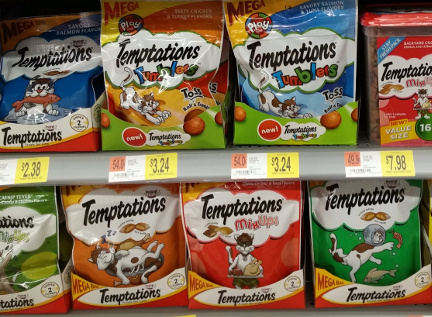Shelf-Ready Packaging Gains
Foothold On Walmart Shelves

By John Kalkowski, editor in chief, Food Online
For nearly a decade, the use of shelf-ready packaging (SRP) has been growing among U.S. retailers. At first, its presence seemed a bit of a novelty and was easily noticeable. Now, retailers and Consumer Packaged Goods companies (CPGs) have incorporated it into their merchandising in all channels — from convenience stores to warehouse stores.
It has become an important element of the consumer’s shopping experience. It also has been shown that SRP can reduce stocking, time, save labor, improve shelf presence, and boost sales.
Walmart was one of the early proponents of SRP. Food Online met with Chet Rutledge, Walmart’s director of private label packaging, to discuss the status of SRP in the market today.
Food Online: 10 years ago, shelf-ready packaging (SRP, also known as retail-ready packaging) seemed an innovation that was ready to take the market by storm in the U.S. What is the status today?
 Rutledge: Shelf-Ready/Retail-Ready Packaging is actively used for a wide variety of products. There hasn’t been a wholesale change to SRP, but it has been more tactical and tailored to products that lend themselves to the format. Generally, these are smaller, high-volume items in pouches that are eight ounces or less. Pet treats are heavy users of SRP, as well as drink mixes, heat-and-eat dinners, and rice meals.
Rutledge: Shelf-Ready/Retail-Ready Packaging is actively used for a wide variety of products. There hasn’t been a wholesale change to SRP, but it has been more tactical and tailored to products that lend themselves to the format. Generally, these are smaller, high-volume items in pouches that are eight ounces or less. Pet treats are heavy users of SRP, as well as drink mixes, heat-and-eat dinners, and rice meals.
Food Online: Have you seen any recent innovations in shelf-ready packaging?
Rutledge: Shredded cheese is one of the more recent applications. By changing from a peg-hooked pillow pouch to a stand-up gusseted pouch, Walmart has been able to shelve these products instead of manually placing them on pegs. This has required the development of specially designed, corrugated cartons that do double duty. They are the shipping case, as well as the shelf-display case. This required capital investment by our cheese suppliers. Capital investments and line changes require more due diligence and planning to ensure that they meet all parties’ ROI objectives. It has to make financial sense to make the investments.
Food Online: SRP is designed to make shelf replenishment more efficient. How does SRP help Walmart in its business model?
Rutledge: The short answer is yes. It is difficult to pinpoint the efficiency gained, but it is intuitive that stocking multiple items in one motion is more effective than stocking single items multiple times.
Food Online: In what areas is Walmart making best use of SRP?
Rutledge: SRP is often referred to as PDQs in the Walmart vernacular. They ultimately mean the same thing. We see SRP/RRP/PDQs being used throughout the store for seasonal items, promotional items, impulse items, candy, food, pet treats, even eggs.
Food Online: Does SRP help Walmart optimize use of shelf space?
Rutledge: There is always the concern that placing product in any secondary container is taking up more shelf space. That is why proper front-end design is critical and needs to be part of the early development process, along with modular/space planning (planograms).
 Food Online: Walmart uses SRP extensively in some grocery segments, such as baby food, candy, and pet food. Why hasn’t its use spread as rapidly in other areas?
Food Online: Walmart uses SRP extensively in some grocery segments, such as baby food, candy, and pet food. Why hasn’t its use spread as rapidly in other areas?
Rutledge: A couple of reasons come to mind. The products need to be evaluated to determine if they are good candidates for SRP. Bulky, heavy products don’t make sense for its use. Small items, pouched product, odd-shaped items that require time and attention to stock are likely candidates for SRP. Non-refrigerated items should be looked at first. Refrigerated/frozen items (we do have some in SRP) have more environmental requirements as they are more prone to condensation and moisture effects than dry products.
Food Online: Are there certain types of packaging that work better as SRP?
Rutledge: Paperboard cartons/trays work well along with small-micro flute corrugated trays and boxes. Die-cut corrugated boxes are very common, but run the risk of strength loss when fully perforated. Thermoformed tray carriers work well for some products and are commonly used in Europe and sometimes here in the U.S. for some items, such as beauty and cosmetic products.
Food Online: Does RRP help increase sales? If so, how?
Rutledge: Being able to restock the shelf in a faster, more-efficient way gives the retailer the ability to reduce out of stock items. If it’s not on the shelf or in stock, we can’t sell it.
Food Online: How important is decoration on SRP?
Rutledge: I’m a huge fan of integrated graphics in which the pouch and artwork on the SRP mesh well with what is being sold. Some SRP trays or cases have no decoration. Sometimes the SRP even covers image on the package. Tying the graphics together can create a billboard that consumers see from a distance.
Food Online: Is there any hurdle that is preventing greater use of SRP?
Rutledge: The biggest hurdle is the current infrastructure of product manufacturers. Capital investment is always a hurdle that must be considered. The biggest opportunity is for suppliers to be looking around the corner at future equipment needs. As old equipment is replaced, they should be looking at new packaging improvements — not just a new machine to make the same old widget.
Food Online: How important is packaging cost in determining use of SRP?
Rutledge: Packaging cost is always a key consideration. I personally think it becomes a central focal point when it should be looked at as a part of the total product and delivery system. “SRP costs more” is usually the first response from every supplier I’ve talked with. When looked at as a single cost point, this may be true part of the time. More often than not, I’ve been able to work with suppliers to redesign their packaging system (primary, secondary, and tertiary) to optimize the packaging to offset any material costs. Generally, by optimizing and right-sizing the packaging, we have been able to reduce material requirements and improve unit size for better shelf utilization, as well as pallet fit for freight and warehouse savings. It is imperative that the total packaging system be reviewed and optimized instead of making a knee-jerk “it costs more” reaction. Packaging is a delivery system for the product and should be viewed as part of a total landed cost instead of the normal line item cost that most buyers and sourcing consider it to be.
Food Online: In many cases, primary packaging has been light-weighted or switched to flexible packaging. Do these changes make it necessary to strengthen the SRP secondary packaging?
Rutledge: Primary and secondary packaging must be designed to work together. Reducing or light-weighting one often requires beefing up the other. Cartons inside a case can share some of the stacking strength requirements, whereas a stand-up pouch should not be counted on to withstand a static load. That requires the shipper case to shoulder the load. Light-weighting is a game of give and take and must be evaluated to determine if the overall reductions of one offset the added strength requirements of the other components. Most often, the biggest mistake is that the packaging materials are supplied by different suppliers or manufacturers. They rarely discuss how their packaging products interact. When there is a failure, it turns into a finger-pointing exercise.
Food Online: How does use of RRP affect the logistics of the supply chain (shipping, stacking, etc…)?
Rutledge: SRP can pose some initial challenges, and there are always unintended consequences. An example is the new, shredded cheese SRP that we rolled out this year. In essence, it is two small cases formed and glued together. They ship oriented in one direction and are broken apart and rotated to fit the shelf in another direction. The initial concern was transitioning from pallet to shelf and changing orientation of the case. What turned out to be the biggest challenge was identifying the joined case as a single case on the pallet. The way the case was marked and positioned, it actually looked like two separate cases on the pallet. So, if there were 10 cases per layer, the person receiving the pallet may confuse it and count 20 cases per layer because there was a visible gap in the middle of the case and two separate sets of print on either side. We ended up changing the way the cases were marked to help identify it as single case.
Another concern is that highly-perforated boxes are subject to strength loss. This makes it crucial that perforation patterns are fully tested to make sure that they will hold up in transit yet be easy to open at the store shelf. Not an easy task.
Food Online: How have store workers and consumers accepted the use of SRP?
Rutledge: I’m seeing more SRP in stores everywhere. If the package is intuitive and its opening is easy to understand, the greater acceptance I’ve seen. Keeping it simple should always be the first rule of thumb. We too often get caught up in new elaborate designs that look and feel great in the boardroom, but don’t work in the backroom of the store or at the shelf.
Food Online: SRP seems to be more popular among large retailers. Does it also have a place for small retailers or are the differences between retail channels too great?
Rutledge: Absolutely! Labor and the ability to get products on the shelf are extremely important no matter how big or small the retailer is. The challenge between a supercenter and neighborhood market is size and assortment. Pack size is the biggest challenge that we face with SRP. The volume and size of a supercenter may be able to accommodate a large pack size of 24 items, whereas a small-format store can only hold four to six items on the shelf. Variable pack sizes are the biggest challenges that most manufacturers will face. There’s no easy answer for this.
Food Online: How important is recycled content and recyclability?
Rutledge: Increasing recycle content is part of Walmart’s sustainability objectives. However, we need to balance performance and recoverability as the most crucial aspects of the package.
Food Online: Are CPGs making sure their SRP meets the “Five Easies” guidelines (Easy to identify, open, stock, shop, and dispose)?
Rutledge: This is key criteria for SRP, but Walmart is relying on our suppliers to ensure that these are the key elements of the package.
